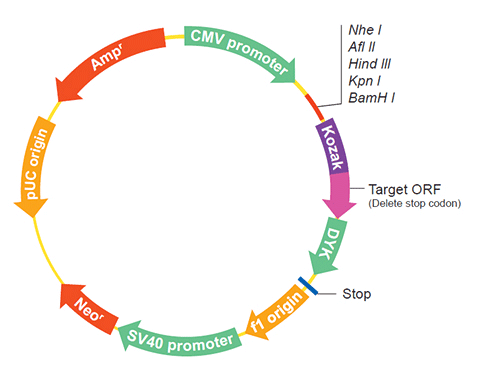| Gene Symbol | KIR3DL10 |
| Entrez Gene ID | 100125558 |
| Full Name | killer immunoglobulin-like receptor KIR3DL10 |
| Gene Type | protein-coding |
| Organism | Macaca mulatta(Rhesus monkey) |
HOME
ORF » Species Summary » Macaca mulatta » KIR3DL10 cDNA ORF clone
| Gene Symbol | KIR3DL10 |
| Entrez Gene ID | 100125558 |
| Full Name | killer immunoglobulin-like receptor KIR3DL10 |
| Gene Type | protein-coding |
| Organism | Macaca mulatta(Rhesus monkey) |
| mRNA | Protein | Name |
|---|---|---|
| NM_001105170.1 | NP_001098640.1 | killer immunoglobulin-like receptor KIR3DL10 precursor |

| Pan troglodytes (chimpanzee) | KIR3DS1 | XP_003953668.1 |
| Pan troglodytes (chimpanzee) | KIR2DL6 | XP_003953671.1 |
| KIRDL8 | NP_001098642.1 | |
| KIR3DH5 | NP_001098643.1 | |
| LOC100125568 | NP_001098645.1 | |
| Homo sapiens (human) | KIR3DL2 | NP_006728.2 |
| Pan troglodytes (chimpanzee) | KIR3DL5 | NP_001098079.1 |
| MAMU-KIR | NP_001098025.1 | |
| KIR3DL12 | NP_001098641.1 | |
| KIR3DL21 | NP_001098023.1 | |
| KIR3DL10 | NP_001098640.1 | |
| LOC100125569 | NP_001098646.1 | |
| LOC100424211 | XP_002801535.1 |

Decreased NK cell frequency and function is associated with increased risk of KIR3DL allele polymorphism in simian immunodeficiency virus-infected rhesus macaques with high viral loads.
Bostik P, Kobkitjaroen J, Tang W, Villinger F, Pereira LE, Little DM, Stephenson ST, Bouzyk M, Ansari AA
Journal of immunology (Baltimore, Md. : 1950)182(6)3638-49(2009 Mar)
Single haplotype analysis demonstrates rapid evolution of the killer immunoglobulin-like receptor (KIR) loci in primates.
Sambrook JG, Bashirova A, Palmer S, Sims S, Trowsdale J, Abi-Rached L, Parham P, Carrington M, Beck S
Genome research15(1)25-35(2005 Jan)
Diversity of the killer cell Ig-like receptors of rhesus monkeys.
Hershberger KL, Shyam R, Miura A, Letvin NL
Journal of immunology (Baltimore, Md. : 1950)166(7)4380-90(2001 Apr)
GeneRIFs: Gene References Into Functions What's a GeneRIF?
The following KIR3DL10 gene cDNA ORF clone sequences were retrieved from the NCBI Reference Sequence Database (RefSeq). These sequences represent the protein coding region of the KIR3DL10 cDNA ORF which is encoded by the open reading frame (ORF) sequence. ORF sequences can be delivered in our standard vector, pcDNA3.1+/C-(K)DYK or the vector of your choice as an expression/transfection-ready ORF clone. Not the clone you want? Click here to find your clone.
| CloneID | OMb23892 | |
| Clone ID Related Accession (Same CDS sequence) | NM_001105170.1 | |
| Accession Version | NM_001105170.1 Latest version! | Documents for ORF clone product in default vector |
| Sequence Information | ORF Nucleotide Sequence (Length: 1341bp) Protein sequence SNP |
|
| Vector | pcDNA3.1-C-(k)DYK or customized vector |  User Manual User Manual |
| Clone information | Clone Map |  MSDS MSDS |
| Tag on pcDNA3.1+/C-(K)DYK | C terminal DYKDDDDK tags | |
| ORF Insert Method | CloneEZ™ Seamless cloning technology | |
| Insert Structure | linear | |
| Update Date | 2013-04-17 | |
| Organism | Macaca mulatta(Rhesus monkey) | |
| Product | killer immunoglobulin-like receptor KIR3DL10 precursor | |
| Comment | Comment: PROVISIONAL REFSEQ: This record has not yet been subject to final NCBI review. The reference sequence was derived from AY728183.1. ##Evidence-Data-START## Transcript exon combination :: AY728183.1 [ECO:0000332] ##Evidence-Data-END## | |
1 | ATGTCGCTCA TGGTCCTCAG CGTGGCGTGT GTTGGGTTCT TCTTGGTCCA GAGGGCCTGT |
The stop codons will be deleted if pcDNA3.1+/C-(K)DYK vector is selected.
| RefSeq | NP_001098640.1 |
| CDS | 7..1347 |
| Translation |

Target ORF information:
Target ORF information:
|
 NM_001105170.1 NM_001105170.1 |

1 | ATGTCGCTCA TGGTCCTCAG CGTGGCGTGT GTTGGGTTCT TCTTGGTCCA GAGGGCCTGT |
The stop codons will be deleted if pcDNA3.1+/C-(K)DYK vector is selected.
Decreased NK cell frequency and function is associated with increased risk of KIR3DL allele polymorphism in simian immunodeficiency virus-infected rhesus macaques with high viral loads. |
Single haplotype analysis demonstrates rapid evolution of the killer immunoglobulin-like receptor (KIR) loci in primates. |
Diversity of the killer cell Ig-like receptors of rhesus monkeys. |